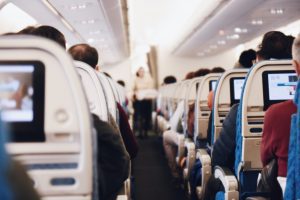By: Beatrice Silva

2 min read July 2020 — Summer this year is drastically different. Instead of hopping on planes to visit friends and family or finally embarking on that European adventure, the majority of frequent travelers are staying put, at least for the time being. It started to become apparent around the second week of March that the novel coronavirus would have a severe impact on the air transport industry. Even some of the busiest airports like Philadelphia International are feeling the weight of uncertainty. Nevertheless, the aviation industry continues to push forward. New air travel innovations have emerged and some airlines have even rediscovered ways to use their aircraft as they weather the turbulence.
Greater Philadelphia is the eighth-largest metropolitan area in the United States and is located in the middle of one of the largest catchment areas with passport holders spanning from South Jersey all the way to New York, according to PHL CASRIP. Philadelphia International Airport is the only international airport that not only serves Philly but the northeast region as a whole. Just last year, the PHL welcomed more than 33 million passengers. It was the largest amount of traffic the airport has ever seen and what makes that figure even more impressive is that fact that there are 29 other airports within a 50 mile radius. So while it may take years for the airport to return to those 2019 levels, there is still hope for air transportation. On July 16, American Airlines and JetBlue announced their strategic partnership that will create seamless connectivity for travelers in the Northeast. This will help to provide more choices for passengers across their complementary domestic and international networks.
“Our innovative partnership will allow us to compete in the New York market where American and JetBlue have traditionally been third and fourth. This partnership will allow us to coordinate schedules so we can provide customers better connectivity, capitalizing on JetBlue’s strengths in the New York market and American’s strengths as a long-haul carrier. Ideally, we envision a time where our passengers can travel into New York on JetBlue and connect with American Airlines for a long-haul flight out of JFK. So it opens up a tremendous amount of new markets to both JetBlue and American customers, complementing our trans-Atlantic gateway in Philadelphia,” Jim Moses, vice president for American Airlines PHL Hub Operations, told Invest: Philadelphia.
Forming strategic partnerships with the competition is just one way airlines are navigating the pandemic. A majority of aviation companies are also adjusting their travel schedules, waiving ticket alteration fees and offering flights at a much lower fare. When it comes to cleanliness airlines are making sure to broadcast their meticulous efforts. Major U.S. airlines like Delta, American, JetBlue and United are in close contact with health agencies such as the World Health Organization and the Centers for Disease Control to make sure their guidelines for cleaning their aircraft cabins are up to par.
As for Philadelphia International Airport, customers and employees are required to wear marks. Their TSA screening process has been modified to protect passengers and new touchless check-in technology has started to emerge. PHL also launched an initiative that offers airlines financial stimulus to encourage carriers to fly to certain destinations and to expand their cargo services. “PHL believes that this rapid injection of relief and growth will jumpstart the entire airport ecosystem, thus benefiting the Philadelphia region,” Stephanie Wear, director of air service development and cargo services, told Airport Experience News. “From concessions to ground transportation to tourism and commerce, the halo effect of increased air travel will create immediate wins for all airport stakeholders.”
